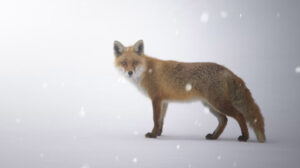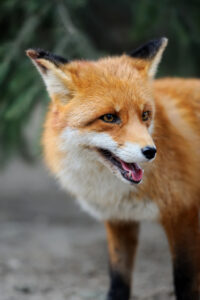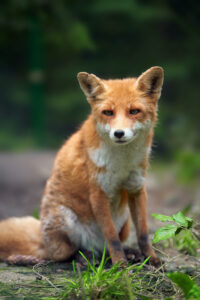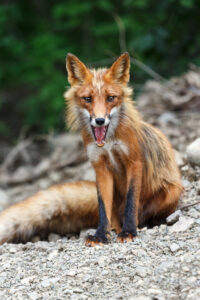Red foxes are found throughout the northern hemisphere from the Arctic circle to North Africa, Central America, and the steppes of Asia. In North America, red foxes are found in every Canadian province and territory, as well as every US state except Hawaii.
Red foxes have also been introduced to Australia, where they have become a nuisance to farmers. Native to Europe, North Africa, and Asia, red foxes were introduced to Australia in the 1850s for the purpose of hunting. However, these vixens quickly adapted to their new environment and began preying on the farm animals. In recent years, the government has placed a bounty on red foxes in an effort to control their population.
Despite their wide range, red foxes are not found in dense forests or deserts. They prefer habitats with plenty of cover such as woods, fields, and meadows. However, they are also one of the most adaptable mammals and can live in urban areas such as London and New York City.
If you live in North America or Europe, there's a good chance you've seen a red fox. These cunning creatures are often featured in children's stories and are considered a national symbol in many countries. Though they may look cute, red foxes are wild animals and should not be approached.
Distribution of Red Foxes
Red foxes are native to many parts of the world, including Europe, North America, and Asia. They are one of the most widespread mammals in the world, and can be found in a variety of habitats.
In North America, red foxes are found in the northern parts of the continent, as well as in the Rocky Mountains and the Appalachian Mountains. They are also found in the Great Plains and the Great Lakes region. In Asia, red foxes are found in Mongolia, China, Korea, and Japan.
Red foxes have also been introduced to a number of other parts of the world, including Australia, New Zealand, and South Africa. They have also been introduced to some islands in the Caribbean.
Red foxes are generally found in areas with a lot of cover, such as forests, woodlands, and brushy areas. They also commonly live in areas with a lot of human activity, such as farms, parks, and suburban areas.
The red fox is a relatively small mammal, with adults typically measuring between 15 and 20 inches in length. They have a reddish brown coat, which helps to camouflage them in their natural habitats. Red foxes typically live for around 10 years in the wild.
Threats to Red Foxes
Red foxes are native to many parts of the world, including North America, Europe, and Asia. However, these beautiful animals are facing many threats.
One of the biggest threats to red foxes is habitat loss. As humans continue to develop more and more land, red foxes are being pushed out of their natural homes. This loss of habitat can lead to reduced food availability, as well as increased contact with humans and domestic animals. This contact can lead to disease transmission and even vehicle strikes.
Another significant threat to red foxes is hunting. In some parts of the world, red foxes are considered pests and are hunted for their fur. This indiscriminate hunting can have a serious impact on local red fox populations.
climate change is also a threat to red foxes. As the planet warms, red foxes may be forced to move to new areas in search of suitable habitat. This can lead to increased conflict with other animals, as well as humans.
Red foxes are an important part of the ecosystem, and it's vital that we do what we can to protect them. By creating wild areas where they can live undisturbed, and by educating people about the importance of these animals, we can help ensure that red foxes will be around for generations to come.
Conservation Efforts for Red Foxes
The Red Fox is one of the most widely distributed and abundant mammals in the world, with a range that extends across North America, Europe, Asia and Australia. However, despite its vast range, the Red Fox is facing significant threats in many parts of the world and is classified as a species of Least Concern on the IUCN Red List.
There are many reasons for the decline of the Red Fox, including habitat loss, hunting and disease. However, there are also many conservation efforts underway to try and protect this amazing animal.
In North America, the Red Fox is protected under the Endangered Species Act and is also listed as a game animal in many states. Hunting of Red Foxes is regulated in order to ensure sustainable populations. In addition, many organizations are working to protect and restore Red Fox habitat across North America.
In Europe, the Red Fox is also facing many threats, but there are also many conservation efforts underway. The European Red Fox is protected under the Bern Convention and many countries have laws in place to protect this species. In addition, many NGOs are working to protect and restore Red Fox habitat across Europe.
There are also many conservation efforts underway in Asia and Australia to protect the Red Fox. In Asia, the Red Fox is protected under the Convention on the Conservation of Migratory Species of Wild Animals (CMS) and many countries have national laws in place to protect this species. In Australia, the Red Fox is listed as a pest species and is subject to control measures. However, there are also many organizations working to conserve this species.
The Red Fox is a beautiful and iconic animal that is facing many threats. However, there are also many conservation efforts underway to try and protect this amazing animal.
Interesting Facts About Red Foxes
Red foxes are beautiful creatures that are native to many parts of the world. Though they are often considered pests, they play an important role in the ecosystem. Here are some interesting facts about red foxes that you may not know!
Red foxes are not actually red.
Their fur is actually a mix of red, yellow, silver, and white. It is only the tips of their hair that are truly red.
Red foxes are the largest of the true foxes.
They can weigh anywhere from 6 to 15 pounds, with the males being larger than the females.
Red foxes are very intelligent.
They are one of the most intelligent animals in the world and are known for their cunning and resourcefulness.
Red foxes have excellent hearing.
They can hear sounds that are up to four times quieter than what humans can hear. This helps them to avoid predators and to find prey.
Red foxes have a very keen sense of smell.
They can smell food that is up to 1 mile away!
Red foxes are mostly nocturnal.
They do the majority of their hunting and foraging at night.
Red foxes are very fast runners.
They can run up to 30 miles per hour!
Red foxes are excellent swimmers.
Though they typically avoid water, they are quite good at swimming and have been known to cross large rivers.
Red foxes are not always solitary creatures.
They often live in pairs or small family groups. However, they will also sometimes form large packs.
Red foxes are found in many parts of the world.
They are native to North America, Europe, Asia, and Australia.





